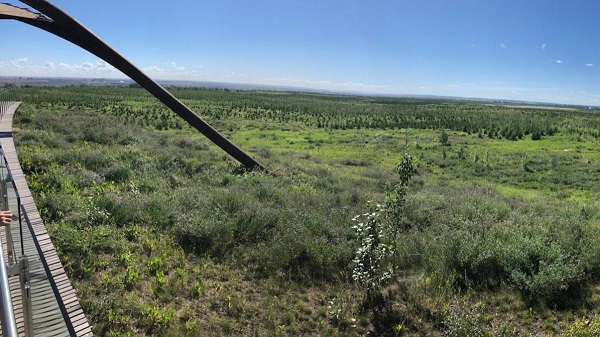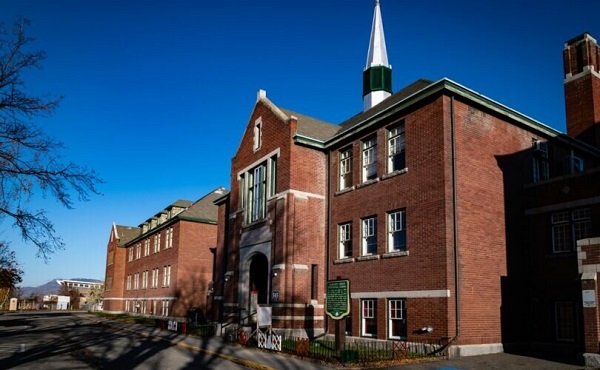Canadian Energy Centre
Completing Trans Mountain, Indigenous LNG: What to watch in Canadian energy in 2024

Workers lay pipe during construction of the Trans Mountain pipeline expansion on farmland in Abbotsford, B.C., on May 3, 2023. CP Images photo
From the Canadian Energy Centre
By Deborah JaremkoActivity promises to highlight Canada’s position as a world supplier of choice
It’s going to be a big year for Canadian energy, with major milestones anticipated that will transform Canada from a supplier with a single customer (the United States) to a global player.
Global demand for oil and gas is expected to stay strong in the decades ahead as the world works to reduce emissions, still supplying nearly half of energy needs in 2050, according to the International Energy Agency.
Activity in 2024 promises to highlight Canada’s position as a supplier of choice with a leading approach to reducing emissions and engaging Indigenous communities.
Here are five things to watch.
5. Start-Up Activities for LNG Canada

Construction of the LNG Canada export terminal is now more than 90 per cent complete. Photo courtesy LNG Canada
Against the backdrop of surging liquefied natural gas (LNG) demand – Asia’s consumption hit a record 26.6 million tonnes in December – Canada’s first LNG export terminal is preparing for start-up.
LNG Canada will have among the world’s lowest emissions for LNG supply, at 0.15 tonnes of CO2 equivalent per tonne of LNG, less than half the global average.
This year, the terminal at Kitimat, B.C. will test and fine-tune equipment and the process of producing LNG will begin, the company says.
The start-up program will take more than one year to complete.
Moving into the final stages at LNG Canada follows the recent completion of the Coastal GasLink Pipeline, connecting natural gas supply from northeast B.C.
4. Progress Toward Oil Sands Net Zero

The Pathways Alliance has extensive work underway on the environmental program for its proposed CCS project, involving 135 experts ranging from aquatic and wildlife biologists to archeologists and paleontologists who have spent more than 1,600 hours in the field working to minimize environmental disturbance. Photo courtesy Pathways Alliance
Major regulatory applications are expected in 2024 for one of the world’s largest proposed carbon capture and storage (CCS) networks, located in Canada’s oil sands.
The project would connect CO2 captured at an initial 14 oil sands facilities by pipeline to a shared hub for storage deep underground.
It is the foundation of the plan by the Pathways Alliance – companies representing 95 per cent of oil sands production – to reduce emissions from operations by nearly one third by 2030 on the way to net zero by 2050.
Pathways has said that after regulatory approvals are complete, CO2 injection and storage could begin by late 2026.
3. Growth in Indigenous Ownership

Eva Clayton, back left, President of the Nisga’a Lisims Government (joint venture owner of the proposed Ksi Lisims LNG project), Crystal Smith, back right, Haisla Nation Chief Councillor (joint venture owner of proposed Cedar LNG project), and Karen Ogen, front right, CEO of the First Nations LNG Alliance pose for a photograph on the HaiSea Wamis zero-emission tugboat outside the LNG2023 conference, in Vancouver, B.C., Monday, July 10, 2023. CP Images photo
The rising tide of Indigenous ownership in Canadian energy is likely to continue growing in 2024.
From LNG terminals to oil and gas pipelines, natural gas-fired power plants and CCS projects to reduce emissions, more Indigenous communities are taking on a leadership role.
Since 2022, more than 75 First Nations and Métis communities in Alberta and British Columbia have agreed to ownership stakes in energy projects including the Coastal GasLink pipeline and major oil sands transportation networks.
Indigenous loan guarantee programs like those offered by the Alberta Indigenous Opportunities Corporation (AIOC) are helping communities invest.
So far, the AIOC has underwritten more than $500 million in loan guarantees. This year it has $3 billion of support available, up from $2 billion in 2023.
Details of a proposed national loan guarantee program to help facilitate Indigenous equity ownership in major resource projects are also expected in the federal budget this spring.
2. Green Light for Cedar LNG
Owners of the world’s first Indigenous-led LNG project – a floating terminal at Kitimat, B.C. –plan to make the final decision to proceed within the next three months.
Cedar LNG, owned jointly by the Haisla Nation and Pembina Pipeline Corporation, would have capacity to export three million tonnes of LNG per year, primarily to Asian markets.
With emissions intensity of 0.08 tonnes of CO2 equivalent per tonne of LNG, it would be one of the lowest carbon footprint LNG projects in the world.
In early January, the partners reached the critical milestone of selecting the primary contractors to engineer, build and deliver the floating LNG unit.
A final investment decision is now expected in the first quarter of 2024.
1. Completion of the Trans Mountain Pipeline Expansion
After more than 12 years in the making, Canada’s first large-scale access to growing global oil markets is now weeks away from completion.
The existing Trans Mountain pipeline system from Edmonton, Alberta to Burnaby, B.C. runs consistently at maximum capacity with producers seeking more export space than is available.
The expansion will increase service by about 600,000 barrels per day, bringing more Canadian oil to customers around the world, primarily on the U.S. west coast and Asia.
After the recent resolution of a regulatory delay, Trans Mountain can now proceed with the last two per cent of construction.
The company anticipates oil will flow on the expanded line before the end of March.
Canadian Energy Centre
Alberta oil sands legacy tailings down 40 per cent since 2015

Wapisiw Lookout, reclaimed site of the oil sands industry’s first tailings pond, which started in 1967. The area was restored to a solid surface in 2010 and now functions as a 220-acre watershed. Photo courtesy Suncor Energy
From the Canadian Energy Centre
By CEC Research
Mines demonstrate significant strides through technological innovation
Tailings are a byproduct of mining operations around the world.
In Alberta’s oil sands, tailings are a fluid mixture of water, sand, silt, clay and residual bitumen generated during the extraction process.
Engineered basins or “tailings ponds” store the material and help oil sands mining projects recycle water, reducing the amount withdrawn from the Athabasca River.
In 2023, 79 per cent of the water used for oil sands mining was recycled, according to the latest data from the Alberta Energy Regulator (AER).
Decades of operations, rising production and federal regulations prohibiting the release of process-affected water have contributed to a significant accumulation of oil sands fluid tailings.
The Mining Association of Canada describes that:
“Like many other industrial processes, the oil sands mining process requires water.
However, while many other types of mines in Canada like copper, nickel, gold, iron ore and diamond mines are allowed to release water (effluent) to an aquatic environment provided that it meets stringent regulatory requirements, there are no such regulations for oil sands mines.
Instead, these mines have had to retain most of the water used in their processes, and significant amounts of accumulated precipitation, since the mines began operating.”
Despite this ongoing challenge, oil sands mining operators have made significant strides in reducing fluid tailings through technological innovation.
This is demonstrated by reductions in “legacy fluid tailings” since 2015.
Legacy Fluid Tailings vs. New Fluid Tailings
As part of implementing the Tailings Management Framework introduced in March 2015, the AER released Directive 085: Fluid Tailings Management for Oil Sands Mining Projects in July 2016.
Directive 085 introduced new criteria for the measurement and closure of “legacy fluid tailings” separate from those applied to “new fluid tailings.”
Legacy fluid tailings are defined as those deposited in storage before January 1, 2015, while new fluid tailings are those deposited in storage after January 1, 2015.
The new rules specified that new fluid tailings must be ready to reclaim ten years after the end of a mine’s life, while legacy fluid tailings must be ready to reclaim by the end of a mine’s life.
Total Oil Sands Legacy Fluid Tailings
Alberta’s oil sands mining sector decreased total legacy fluid tailings by approximately 40 per cent between 2015 and 2024, according to the latest company reporting to the AER.
Total legacy fluid tailings in 2024 were approximately 623 million cubic metres, down from about one billion cubic metres in 2015.
The reductions are led by the sector’s longest-running projects: Suncor Energy’s Base Mine (opened in 1967), Syncrude’s Mildred Lake Mine (opened in 1978), and Syncrude’s Aurora North Mine (opened in 2001). All are now operated by Suncor Energy.
The Horizon Mine, operated by Canadian Natural Resources (opened in 2009) also reports a significant reduction in legacy fluid tailings.
The Muskeg River Mine (opened in 2002) and Jackpine Mine (opened in 2010) had modest changes in legacy fluid tailings over the period. Both are now operated by Canadian Natural Resources.
Imperial Oil’s Kearl Mine (opened in 2013) and Suncor Energy’s Fort Hills Mine (opened in 2018) have no reported legacy fluid tailings.
Suncor Energy Base Mine
Between 2015 and 2024, Suncor Energy’s Base Mine reduced legacy fluid tailings by approximately 98 per cent, from 293 million cubic metres to 6 million cubic metres.
Syncrude Mildred Lake Mine
Between 2015 and 2024, Syncrude’s Mildred Lake Mine reduced legacy fluid tailings by approximately 15 per cent, from 457 million cubic metres to 389 million cubic metres.
Syncrude Aurora North Mine
Between 2015 and 2024, Syncrude’s Aurora North Mine reduced legacy fluid tailings by approximately 25 per cent, from 102 million cubic metres to 77 million cubic metres.
Canadian Natural Resources Horizon Mine
Between 2015 and 2024, Canadian Natural Resources’ Horizon Mine reduced legacy fluid tailings by approximately 36 per cent, from 66 million cubic metres to 42 million cubic metres.
Total Oil Sands Fluid Tailings
Reducing legacy fluid tailings has helped slow the overall growth of fluid tailings across the oil sands sector.
Without efforts to reduce legacy fluid tailings, the total oil sands fluid tailings footprint today would be approximately 1.6 billion cubic metres.
The current fluid tailings volume stands at approximately 1.2 billion cubic metres, up from roughly 1.1 billion in 2015.
The unaltered reproduction of this content is free of charge with attribution to the Canadian Energy Centre.
Business
Why it’s time to repeal the oil tanker ban on B.C.’s north coast

The Port of Prince Rupert on the north coast of British Columbia. Photo courtesy Prince Rupert Port Authority
From the Canadian Energy Centre
By Will Gibson
Moratorium does little to improve marine safety while sending the wrong message to energy investors
In 2019, Martha Hall Findlay, then-CEO of the Canada West Foundation, penned a strongly worded op-ed in the Globe and Mail calling the federal ban of oil tankers on B.C.’s northern coast “un-Canadian.”
Six years later, her opinion hasn’t changed.
“It was bad legislation and the government should get rid of it,” said Hall Findlay, now director of the University of Calgary’s School of Public Policy.
The moratorium, known as Bill C-48, banned vessels carrying more than 12,500 tonnes of oil from accessing northern B.C. ports.
Targeting products from one sector in one area does little to achieve the goal of overall improved marine transport safety, she said.
“There are risks associated with any kind of transportation with any goods, and not all of them are with oil tankers. All that singling out one part of one coast did was prevent more oil and gas from being produced that could be shipped off that coast,” she said.
Hall Findlay is a former Liberal MP who served as Suncor Energy’s chief sustainability officer before taking on her role at the University of Calgary.
She sees an opportunity to remove the tanker moratorium in light of changing attitudes about resource development across Canada and a new federal government that has publicly committed to delivering nation-building energy projects.
“There’s a greater recognition in large portions of the public across the country, not just Alberta and Saskatchewan, that Canada is too dependent on the United States as the only customer for our energy products,” she said.
“There are better alternatives to C-48, such as setting aside what are called Particularly Sensitive Sea Areas, which have been established in areas such as the Great Barrier Reef and the Galapagos Islands.”
The Business Council of British Columbia, which represents more than 200 companies, post-secondary institutions and industry associations, echoes Hall Findlay’s call for the tanker ban to be repealed.
“Comparable shipments face no such restrictions on the East Coast,” said Denise Mullen, the council’s director of environment, sustainability and Indigenous relations.
“This unfair treatment reinforces Canada’s over-reliance on the U.S. market, where Canadian oil is sold at a discount, by restricting access to Asia-Pacific markets.
“This results in billions in lost government revenues and reduced private investment at a time when our economy can least afford it.”
The ban on tanker traffic specifically in northern B.C. doesn’t make sense given Canada already has strong marine safety regulations in place, Mullen said.
Notably, completion of the Trans Mountain Pipeline expansion in 2024 also doubled marine spill response capacity on Canada’s West Coast. A $170 million investment added new equipment, personnel and response bases in the Salish Sea.
“The [C-48] moratorium adds little real protection while sending a damaging message to global investors,” she said.
“This undermines the confidence needed for long-term investment in critical trade-enabling infrastructure.”
Indigenous Resource Network executive director John Desjarlais senses there’s an openness to revisiting the issue for Indigenous communities.
“Sentiment has changed and evolved in the past six years,” he said.
“There are still concerns and trust that needs to be built. But there’s also a recognition that in addition to environmental impacts, [there are] consequences of not doing it in terms of an economic impact as well as the cascading socio-economic impacts.”
The ban effectively killed the proposed $16-billion Eagle Spirit project, an Indigenous-led pipeline that would have shipped oil from northern Alberta to a tidewater export terminal at Prince Rupert, B.C.
“When you have Indigenous participants who want to advance these projects, the moratorium needs to be revisited,” Desjarlais said.
He notes that in the six years since the tanker ban went into effect, there are growing partnerships between B.C. First Nations and the energy industry, including the Haisla Nation’s Cedar LNG project and the Nisga’a Nation’s Ksi Lisims LNG project.
This has deepened the trust that projects can mitigate risks while providing economic reconciliation and benefits to communities, Dejarlais said.
“Industry has come leaps and bounds in terms of working with First Nations,” he said.
“They are treating the rights of the communities they work with appropriately in terms of project risk and returns.”
Hall Findlay is cautiously optimistic that the tanker ban will be replaced by more appropriate legislation.
“I’m hoping that we see the revival of a federal government that brings pragmatism to governing the country,” she said.
“Repealing C-48 would be a sign of that happening.”
-

 COVID-199 hours ago
COVID-199 hours agoFDA requires new warning on mRNA COVID shots due to heart damage in young men
-

 Business7 hours ago
Business7 hours agoCarney’s new agenda faces old Canadian problems
-

 Indigenous8 hours ago
Indigenous8 hours agoInternal emails show Canadian gov’t doubted ‘mass graves’ narrative but went along with it
-

 Daily Caller4 hours ago
Daily Caller4 hours agoBlackouts Coming If America Continues With Biden-Era Green Frenzy, Trump Admin Warns
-

 Bruce Dowbiggin10 hours ago
Bruce Dowbiggin10 hours agoEau Canada! Join Us In An Inclusive New National Anthem
-

 Alberta2 days ago
Alberta2 days agoFourteen regional advisory councils will shape health care planning and delivery in Alberta
-

 Alberta2 days ago
Alberta2 days agoAlberta school boards required to meet new standards for school library materials with regard to sexual content
-

 Business2 days ago
Business2 days agoUN’s ‘Plastics Treaty’ Sports A Junk Science Wrapper











